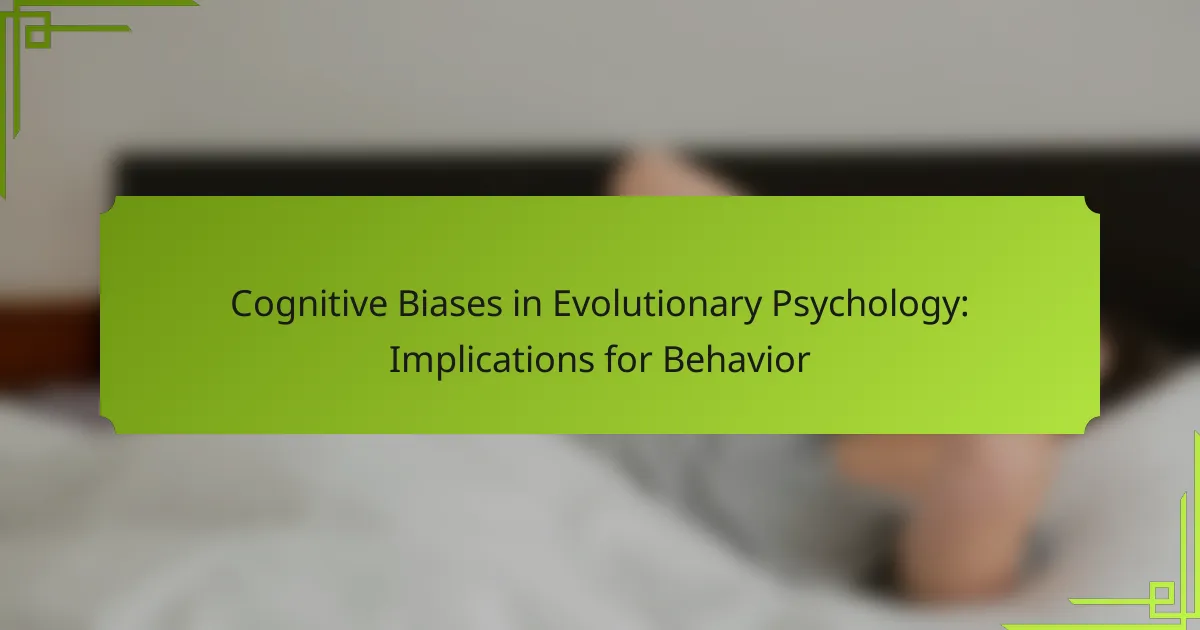Cognitive biases in evolutionary psychology significantly influence human behavior and decision-making. This article explores how these biases arise from adaptive mechanisms, highlights key examples like confirmation bias and the availability heuristic, and examines cultural variations in their manifestations. Understanding these biases is essential for improving judgment and enhancing interpersonal relationships across diverse contexts.
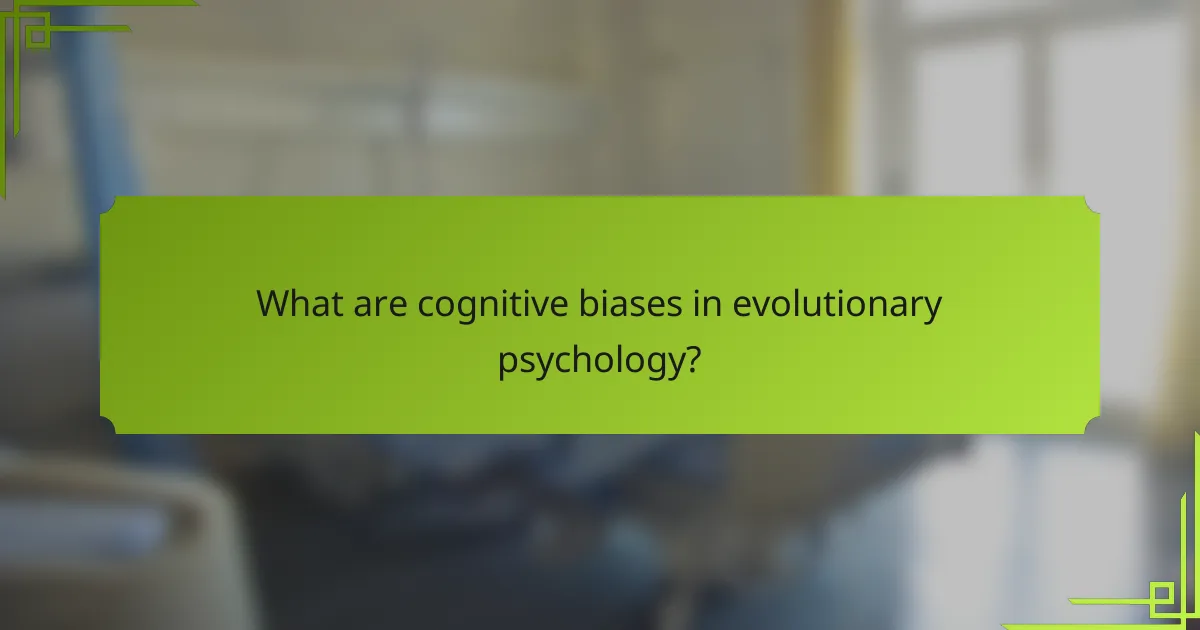
What are cognitive biases in evolutionary psychology?
Cognitive biases in evolutionary psychology are systematic patterns of deviation from norm or rationality in judgment. These biases arise from adaptive mechanisms shaped by natural selection, influencing human behavior and decision-making.
For example, the confirmation bias leads individuals to favor information that confirms their existing beliefs, enhancing group cohesion and survival. Another significant bias is the availability heuristic, where people assess the likelihood of events based on how easily examples come to mind, often influenced by recent experiences or media exposure.
Understanding these biases provides insight into human behavior, revealing how evolutionary pressures continue to shape thought processes. This knowledge can inform various fields, including behavioral economics, marketing, and conflict resolution.
How do cognitive biases influence human behavior?
Cognitive biases significantly shape human behavior by influencing decision-making and perception. These biases stem from evolutionary adaptations, allowing quick judgments that often prioritize survival over accuracy. For instance, the availability heuristic leads individuals to overestimate the likelihood of events based on recent experiences, affecting risk assessment. Additionally, confirmation bias drives people to favor information that supports existing beliefs, impacting social interactions and group dynamics. Understanding these biases can enhance awareness of their effects on behavior, ultimately promoting better decision-making strategies.
What are the key types of cognitive biases?
Cognitive biases significantly influence human behavior and decision-making. Key types include confirmation bias, anchoring bias, availability heuristic, and hindsight bias.
Confirmation bias leads individuals to favor information that confirms their preexisting beliefs. Anchoring bias occurs when people rely too heavily on the first piece of information encountered. The availability heuristic involves overestimating the likelihood of events based on how easily examples come to mind. Hindsight bias is the tendency to see events as having been predictable after they have already occurred.
Understanding these biases can enhance awareness and improve decision-making processes.
How does confirmation bias manifest in decision-making?
Confirmation bias leads individuals to favor information that supports their pre-existing beliefs, impacting decision-making. This cognitive bias often results in selective exposure to data, interpretation of ambiguous evidence, and memory recall that aligns with personal views. As a result, people may overlook contradictory information, leading to flawed judgments. Understanding this bias is crucial in evolutionary psychology, as it highlights how human behavior is influenced by inherent cognitive tendencies.
What role does availability heuristic play in perception?
The availability heuristic significantly influences perception by causing individuals to rely on immediate examples that come to mind. This cognitive bias can lead to distorted judgments and decisions based on recent or vivid experiences rather than objective data. For instance, people may overestimate the risk of rare events, like plane crashes, simply because they are more memorable. This tendency can skew perceptions of reality and impact behaviors, often resulting in irrational fears or misinformed choices. Understanding the availability heuristic is crucial for recognizing its effects on decision-making processes.
How does anchoring bias affect judgments?
Anchoring bias significantly skews judgments by relying heavily on initial information, leading to distorted decision-making. This cognitive bias often results in individuals giving disproportionate weight to the first piece of information encountered, even when it is irrelevant. Research shows that even arbitrary anchors can influence estimates and choices, demonstrating the unique attribute of anchoring bias in shaping perceptions. As a result, awareness of this bias is essential for improving critical thinking and decision-making skills.
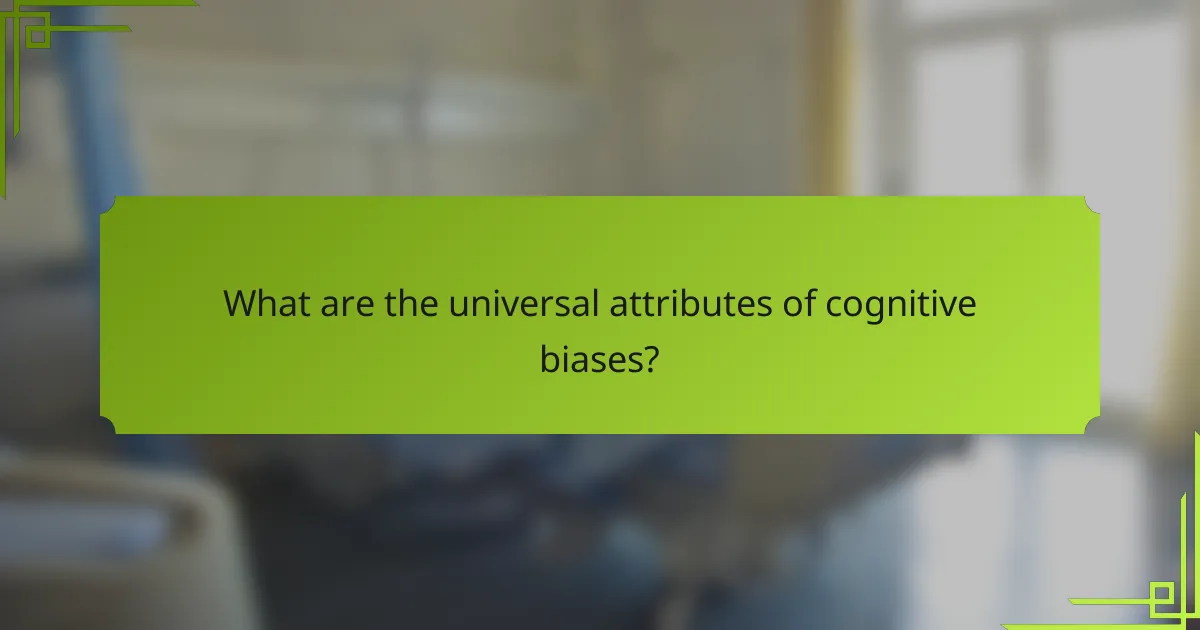
What are the universal attributes of cognitive biases?
Cognitive biases universally arise from mental shortcuts that influence decision-making and judgment. These biases affect perception, reasoning, and behavior across various contexts. Common attributes include heuristics, emotional influences, and social pressures. Unique to cognitive biases is their evolutionary basis, which enhances survival by simplifying information processing. Rarely, specific biases may emerge from cultural contexts, impacting behavior differently in diverse societies.
How do cognitive biases enhance survival and adaptation?
Cognitive biases enhance survival and adaptation by streamlining decision-making processes. These mental shortcuts enable individuals to react quickly to threats, often prioritizing immediate survival over rational analysis. For example, the availability heuristic allows individuals to assess risks based on recent experiences, promoting quicker responses in dangerous situations. This adaptive mechanism can lead to faster decisions that historically increased chances of survival. Furthermore, biases like confirmation bias support social cohesion, enhancing group survival by reinforcing shared beliefs. Overall, cognitive biases play a crucial role in shaping behaviors that align with evolutionary pressures.
What common cognitive biases are found across cultures?
Common cognitive biases found across cultures include confirmation bias, availability heuristic, and anchoring bias. These biases influence decision-making and perception universally, reflecting shared human psychology.
Confirmation bias leads individuals to favor information that confirms existing beliefs. The availability heuristic causes reliance on immediate examples when evaluating a situation. Anchoring bias involves the tendency to rely heavily on the first piece of information encountered.
These biases may manifest differently across cultures but share a foundational impact on behavior and cognition. Understanding these biases can improve cross-cultural communication and decision-making.
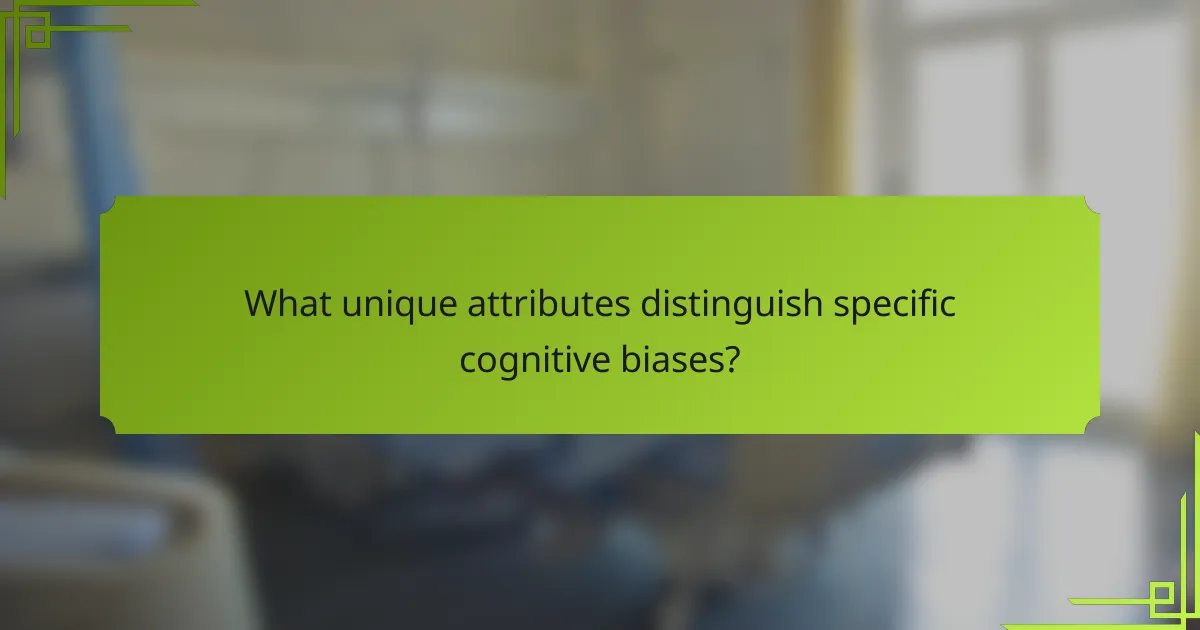
What unique attributes distinguish specific cognitive biases?
Cognitive biases are distinguished by unique attributes that influence decision-making and perception. One notable attribute is the framing effect, where the way information is presented alters choices. Another unique trait is confirmation bias, which leads individuals to favor information that aligns with their preexisting beliefs. Anchoring bias uniquely affects judgments by relying heavily on the first piece of information encountered. These biases illustrate how evolutionary psychology shapes human behavior through cognitive shortcuts.
How does the framing effect uniquely shape choices?
The framing effect significantly influences choices by altering how information is presented. This cognitive bias can lead individuals to make decisions based on the context rather than the actual content. For instance, presenting a medical treatment as having a 90% success rate may encourage acceptance, while framing it as having a 10% failure rate may deter individuals, despite both statements conveying the same information. This unique attribute of the framing effect demonstrates its power in shaping perceptions and choices. Understanding this can enhance decision-making strategies in various fields, including marketing and public health.
What unique cognitive biases are prevalent in social contexts?
Unique cognitive biases in social contexts include the bandwagon effect, where individuals adopt beliefs based on perceived popularity, and the false consensus effect, leading people to overestimate the extent to which others share their views. These biases can significantly influence group dynamics and decision-making. Additionally, the social proof bias causes individuals to look to others for cues on how to behave in uncertain situations. Understanding these biases is crucial for improving interpersonal communication and collaboration.
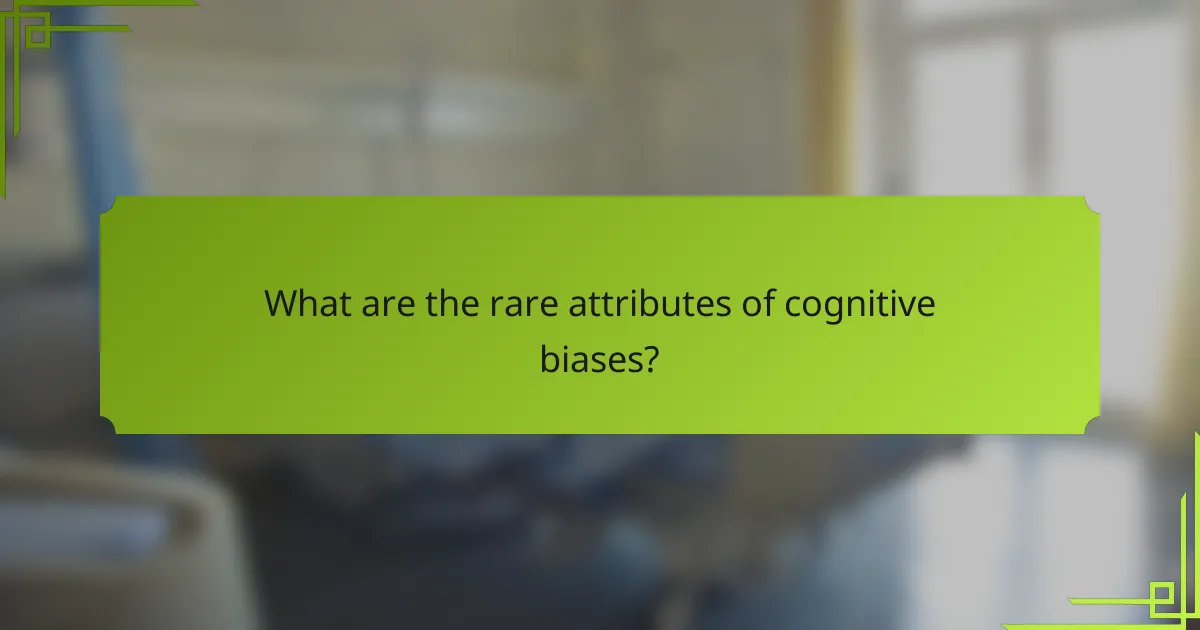
What are the rare attributes of cognitive biases?
Cognitive biases exhibit rare attributes that significantly influence decision-making. These include the illusion of control, where individuals overestimate their influence over outcomes, and the Dunning-Kruger effect, where people with low ability overrate their competence. Another rare attribute is the optimism bias, which leads individuals to believe they are less likely to experience negative events compared to others. These attributes highlight unique aspects of cognitive biases that can shape behavior in evolutionary contexts.
How do rare cognitive biases emerge in specific scenarios?
Rare cognitive biases emerge in specific scenarios due to unique environmental pressures and social contexts. These biases often reflect adaptive responses to challenges faced by individuals or groups. For example, the “sunk cost fallacy” may arise in high-stakes situations where prior investments influence future decisions, demonstrating a unique attribute of decision-making under pressure. Additionally, biases like “groupthink” can manifest in cohesive teams, where the desire for harmony overrides critical analysis, showcasing a rare attribute related to social dynamics. Understanding these scenarios helps illuminate the complexity of human behavior within evolutionary psychology.
What are the implications of less-known biases on behavior?
Less-known biases can significantly influence behavior by shaping perceptions and decision-making processes. Cognitive biases, such as the Dunning-Kruger effect, may lead individuals to overestimate their abilities, affecting their confidence and choices. Additionally, biases like the availability heuristic can skew judgment based on recent experiences, impacting risk assessment and behavior. Understanding these implications aids in recognizing how subtle biases can alter individual and group dynamics, ultimately affecting outcomes in various contexts.

How do cognitive biases vary across different cultures?
Cognitive biases can differ significantly across cultures due to varying social norms, values, and experiences. For instance, collectivist cultures may prioritize group harmony, influencing biases like conformity. In contrast, individualistic cultures might exhibit biases favoring personal achievement. Research indicates that these cultural contexts shape decision-making processes and perceptions, leading to unique manifestations of cognitive biases. Cultural background can also affect the interpretation of risk, with some cultures exhibiting greater aversion to loss than others. Understanding these variations is crucial for improving cross-cultural communication and collaboration.
What cultural factors influence cognitive biases?
Cultural factors significantly influence cognitive biases through shared beliefs, norms, and values. These elements shape perception and decision-making processes across different societies. For instance, collectivist cultures may prioritize group harmony, leading to biases like conformity. In contrast, individualistic cultures might emphasize personal achievement, affecting biases related to self-serving attribution. Additionally, cultural narratives and historical contexts can create unique biases, impacting behaviors and judgments in specific communities. Understanding these influences enhances awareness of cognitive processes and improves decision-making strategies.
How do cognitive biases manifest in specific regions?
Cognitive biases manifest in specific regions through localized decision-making patterns influenced by cultural, social, and environmental factors. For instance, in collectivist societies, biases like conformity may be more pronounced, affecting group dynamics. Conversely, individualistic cultures might exhibit biases favoring personal achievement, impacting choices. Regional variations in cognitive biases can lead to distinct behavioral implications, such as risk perception differing in urban versus rural settings. Understanding these nuances is crucial for applying evolutionary psychology principles effectively.
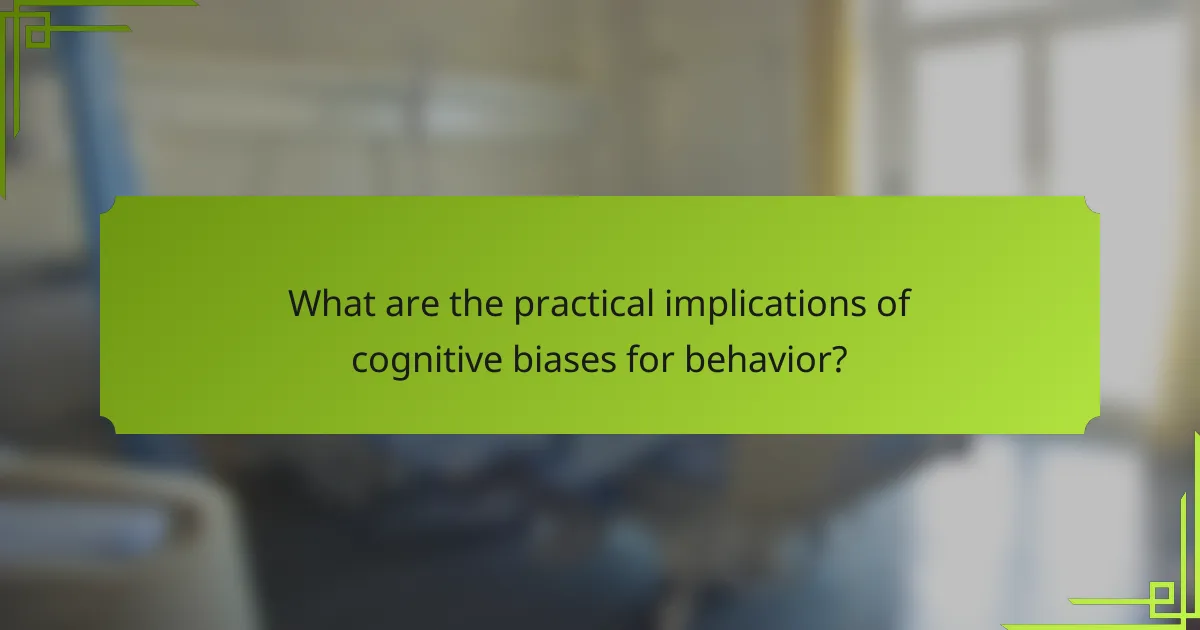
What are the practical implications of cognitive biases for behavior?
Cognitive biases significantly influence behavior by distorting perception and decision-making. These biases can lead to irrational choices, affecting personal and social dynamics. For instance, the confirmation bias causes individuals to favor information that confirms their pre-existing beliefs, leading to poor decision-making. Additionally, the availability heuristic can result in overestimating the importance of recent experiences, skewing risk assessment. Understanding these biases is crucial for improving judgment and fostering better interpersonal relationships.
How can understanding cognitive biases improve decision-making?
Understanding cognitive biases enhances decision-making by promoting awareness of irrational influences. Recognizing biases like confirmation bias or anchoring can lead to more objective evaluations. This awareness encourages critical thinking and reduces errors in judgment, ultimately improving outcomes. Cognitive biases, rooted in evolutionary psychology, reflect adaptive behaviors that can cloud rationality. By addressing these biases, individuals can make more informed decisions, leading to better personal and professional choices.
What strategies can mitigate the impact of cognitive biases?
To mitigate the impact of cognitive biases, individuals can employ several strategies. Awareness of biases is crucial; recognizing them helps in making informed decisions. Critical thinking skills can be enhanced through training, promoting objective analysis of situations. Seeking diverse perspectives encourages balanced viewpoints, reducing the likelihood of biased conclusions. Additionally, structured decision-making processes can help standardize evaluations, minimizing emotional influences. Engaging in reflective practices allows individuals to assess their thought patterns, fostering a deeper understanding of their biases.
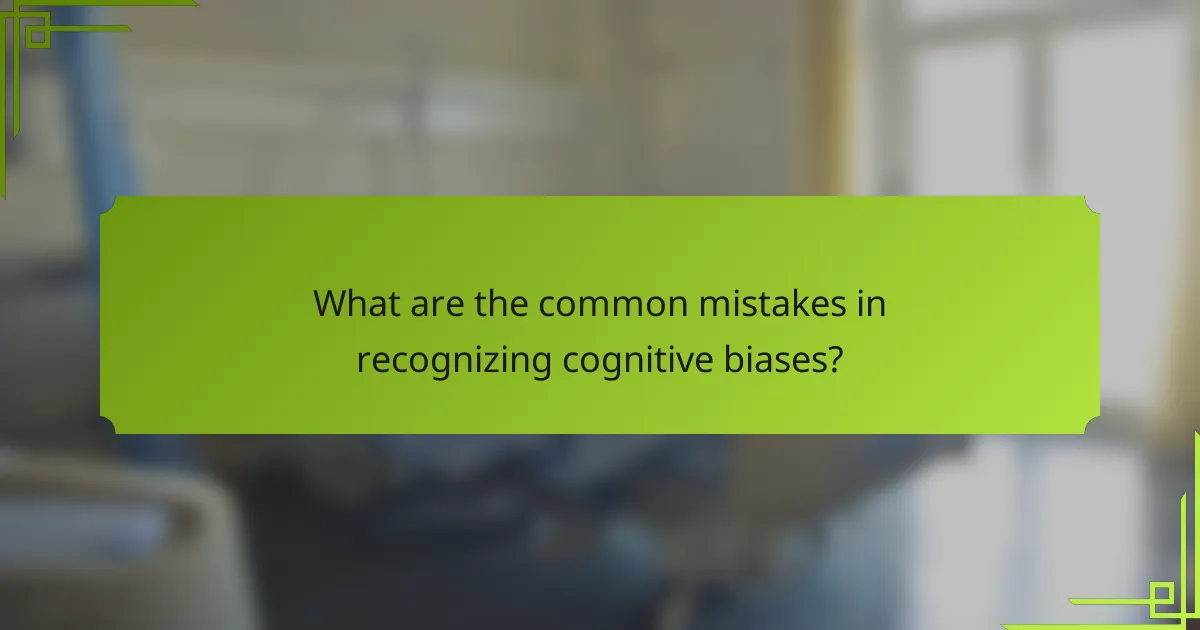
What are the common mistakes in recognizing cognitive biases?
Common mistakes in recognizing cognitive biases include overgeneralization, neglecting context, and failing to account for individual differences. These errors can lead to misinterpretations of behavior and decision-making processes. For example, assuming that everyone is influenced by the same bias disregards unique personal experiences and cultural backgrounds. Additionally, overlooking the situational factors that contribute to biases can result in incomplete analyses. Recognizing these pitfalls is crucial for accurately understanding cognitive biases in evolutionary psychology and their implications for behavior.
How can individuals avoid falling prey to cognitive biases?
Individuals can avoid falling prey to cognitive biases by increasing awareness of these biases and practicing critical thinking. Recognizing common biases, such as confirmation bias and anchoring, enables individuals to question their assumptions. Engaging in reflective thinking and seeking diverse perspectives can further mitigate biases. Regularly challenging one’s beliefs and considering alternative viewpoints fosters a more balanced decision-making process.
What best practices can enhance awareness of cognitive biases?
To enhance awareness of cognitive biases, individuals should adopt critical thinking strategies and engage in reflective practices. Encouraging open discussions about biases can lead to greater recognition and understanding. Training programs focused on cognitive biases can provide practical tools for identifying and mitigating their effects. Additionally, utilizing decision-making frameworks can help individuals evaluate choices more objectively, reducing the influence of biases.
